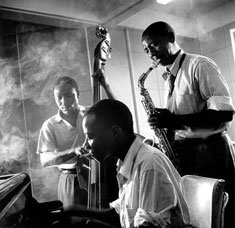South African music: mbaqanga jazz
By the middle of the 1950s, the various strains of South African music were pouring themselves into an exciting melting pot of ideas and forms, propelled in part by the hunger of the vast urban proletariat for entertainment.
A key area in this growth was the Johannesburg township of Sophiatown, which had grown since the 1930s into a seething cauldron of the new urban lifestyles of South Africa's black city dwellers.
In part because of its ambiguous legal status as a "freehold" area, and its proximity to the urban centre of Johannesburg, Sophiatown attracted the most adventurous performers of the new musical forms, and became a hotbed of the rapidly developing black musical culture.
By this time, the old strains of marabi and kwela had begun to coalesce into what is broadly referred to as
mbaqanga, a mode of African-inflected jazz that had many and various
practitioners, with a large number of bands competing for attention and income. Singing stars such as Miriam Makeba, Dolly Rathebe and Letta Mbulu gained fanatical followings.
The cyclic structure of marabi met with traditional dance styles such as the Zulu
indlamu, with a heavy dollop of American big band swing thrown in. The
indlamu tendency crystallised into the "African stomp" style, giving a notably African rhythmic impulse to the music and making it irresistible to its new audiences.
South Africa's new black urban culture (the music was accompanied by a mini-renaissance in other arts such as writing, especially by the group known as the "Drum Generation") also developed a sassy style of its own, based in part on the
influence of American movies and the glamour attached to the flamboyant gangsters who were an integral part of Sophiatown life.
This lawless domain was one in which black South Africans could mingle with the more adventurous and
liberal whites drawn to the excitements of its vibrant nightlife, becoming a touchstone for the first real cultural and social interchange between the races to take place in South Africa.
Eventually, the white Nationalist government brought this vital era to an end,
forcibly removing the inhabitants of Sophiatown to townships such as Soweto,
outside Johannesburg, in 1960. Sophiatown was razed and the white suburb Triomf built in its place.
SAinfo reporter
 The Three Jazzomolos in 1953 - one of a wealth of images of the golden era of Sophiatown captured by veteran South African photographer Jurgen Schadeberg (Image: Jurgen Schadeberg. Please note that this image is strictly copyright)
The Three Jazzomolos in 1953 - one of a wealth of images of the golden era of Sophiatown captured by veteran South African photographer Jurgen Schadeberg (Image: Jurgen Schadeberg. Please note that this image is strictly copyright)


